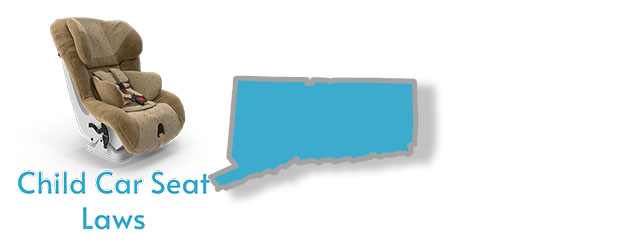A Summary of Child Car Seat Laws in Connecticut
- Children less than 3 years of age weighing less than 30 pounds must ride on a rear-facing seat.
- Toddlers of age range 2 to 4 with a weight of less than 40 pounds should use a forward-facing seat.
- A child can graduate from a booster seat to seat belts once he or she is 8 years and weighs 60 pounds or more.
- It is illegal to leave a child in a car.
Rear-facing Car Seat Laws in Connecticut
Connecticut car seat laws state that children of age 2 or under and with a weight of less than 30 pounds must be placed in a rear-facing seat fitted with a 5 point harness. In this case, the weight of the child is the determining factor since an infant cannot stop using the seat until he or she weighs 30 pounds or more regardless of age. The rear-facing seat must be approved by the Department of Motor Vehicles and should be secured in the back seat away from a functional air bag. Also, parents or caregivers should check the manufacturer’s weight and height guidelines in order to maximize the infant’s safety on the road.
Forward-facing Seat Laws Connecticut
The law requires toddlers between the age of 2 and 4 years old and with a weight of 30-39 pounds to ride on a forward-facing seat with a 5 point harness. If you deem your child too small for his or her age, you can downgrade him or her to a rear-facing seat until the manufacturer’s weight and height limits are exceeded. In addition, the type of seat used must be approved by the Department of Motor Vehicles. Children should remain in a rear-facing seat until they are at least 5 years old and weigh 40 pounds or more.
Booster Seat Laws in Connecticut
Once a child has outgrown a forward-facing car seat, he or she is required to use a booster seat until an age of 8 years old and a weight of 60 pounds or more is attained. Parents have the options of choosing a 5 point harness or a booster seat that must be used together with the car’s shoulder and lap belts. In order to maximize safety, the shoulder belts should fit snugly over the chest area and the lap belt lie across the thigh area of the child. The booster seat must be secured in the back seat and must meet the safety standards set by the Department of Motor Vehicles. Checking the manufacturer’s weight and height guidelines may also help to determine whether your child is still safe in a booster seat.
Front-seat Regulations Connecticut
By law, children 8 years or older who weigh 60 pounds or more are allowed to use a regular seat belt, and therefore sit in the front seat. However, the American Academy of Pediatrics recommends that children should use a regular seat belt once they reach a height of 4’9’’. This is mainly because the car seat belts were designed with the height of an average adult in mind, therefore someone shorter than 4’9’’ may not be comfortable on such seatbelts.
Leaving a child in the vehicle in Connecticut
It is illegal to leave a child in a car no matter the condition, even if the engine is not running. You can face a felony charge for leaving a child younger than 16 years in a car. The law is quite strict in this case so even leaving the child unsupervised for less than 5 minutes is highly discouraged.
We strongly advise you to never leave your child in the vehicle no matter the situation.
More Connecticut Laws
- *Connecticut Recording Laws
- Connecticut Car Seat Laws
- Connecticut Child Support Laws
- Connecticut Hit and Run Laws
- Connecticut Lemon Law
- Connecticut Sexting Laws
- Connecticut Statute of Limitations
- Connecticut Whistleblower Laws
- Dog Bite Laws Connecticut
- Murder Sentencing Guidelines – Minimum to Maximum for Every State
